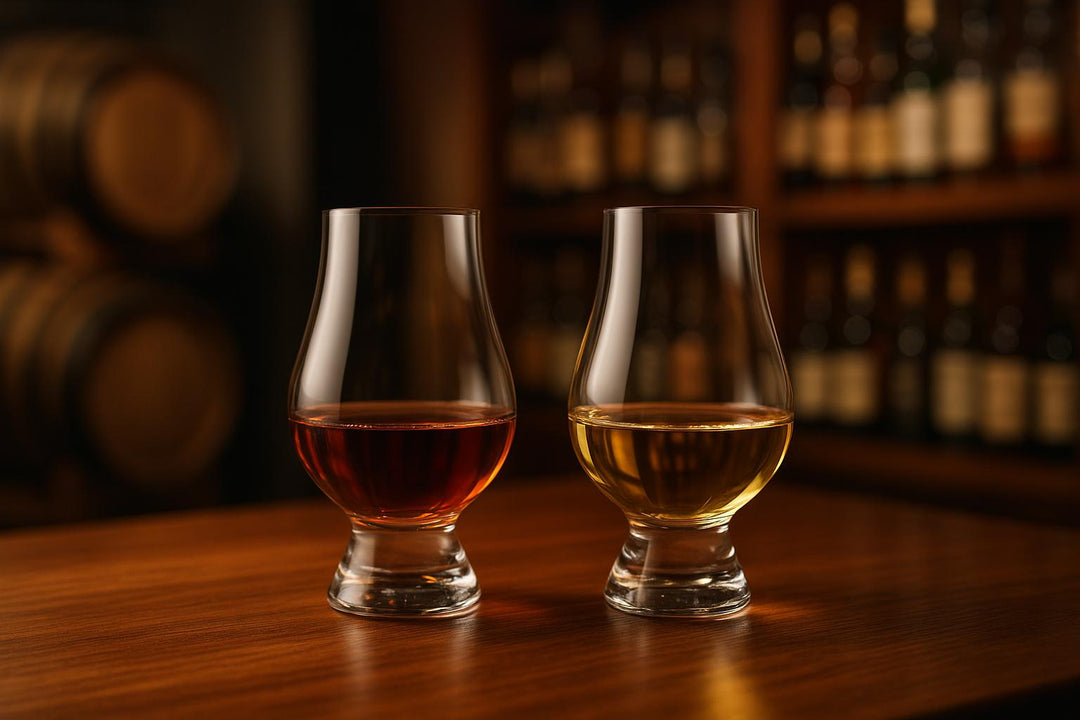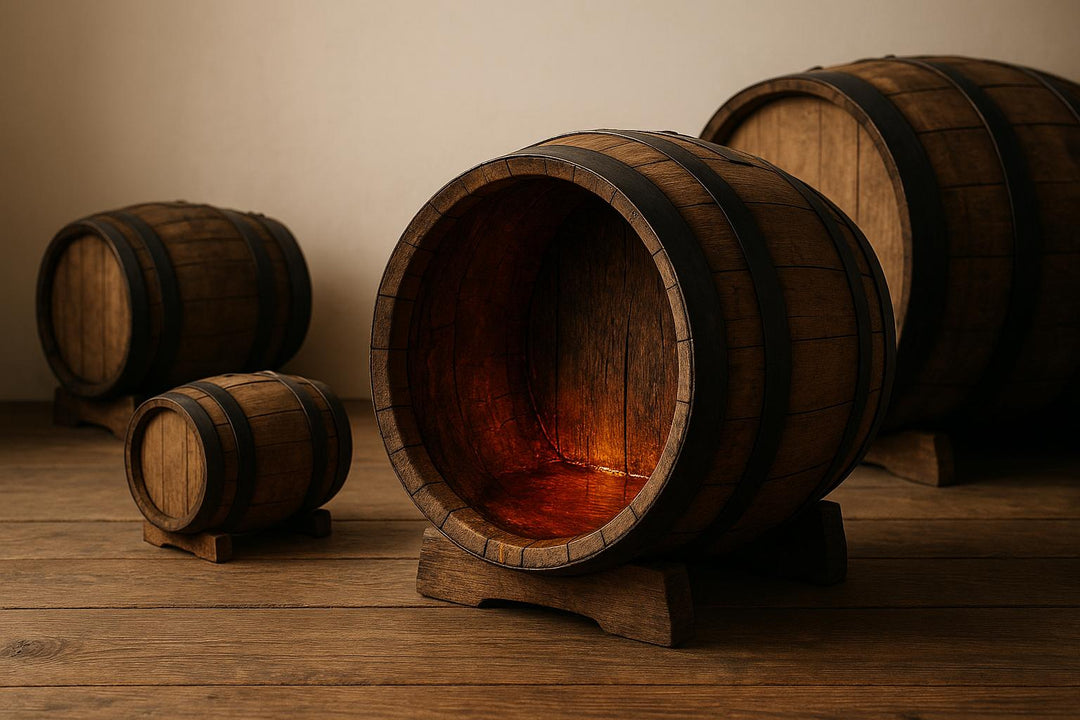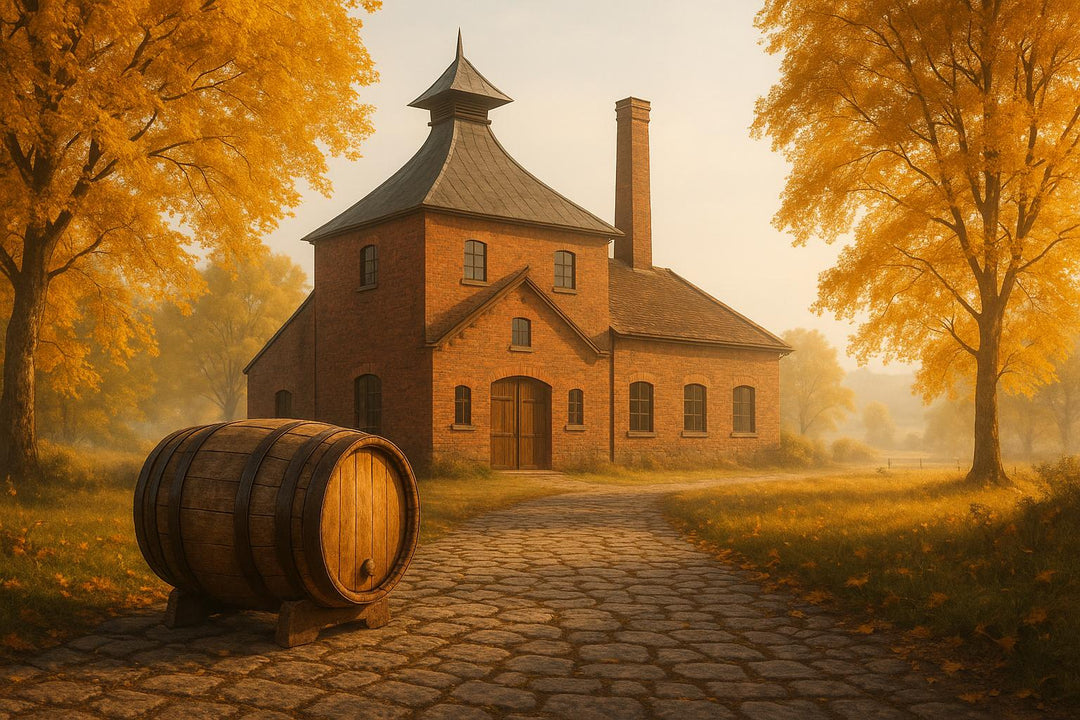Whisky prices are unpredictable, influenced by demand, production challenges, and global economics. Key points:
- Demand vs. Supply: Limited releases or aged whiskies drive up costs, while oversupply, as seen in American bourbon, reduces prices.
- Economic Factors: Inflation, tariffs, and currency shifts impact pricing. For example, US tariffs on Scotch whisky caused £600m in losses between 2019 and 2021.
- Global Events: Political instability, natural disasters, and trade disputes disrupt production and pricing.
- Investment Trends: Rare whisky shows high returns (e.g., 604% growth in Rare Whisky Vintage 50 Index), but risks include fraud and market volatility.
Understanding these factors helps buyers, collectors, and investors navigate the market effectively.
Is Whisky Still a Smart Investment in 2025? The Hard Truth on Bottles & Casks
Main Factors Behind Whisky Price Changes
Whisky prices are shaped by a mix of market forces and external influences, leading to both sudden increases and sharp corrections.
Supply and Demand
The classic economic principle of supply and demand plays a major role in whisky pricing. A clear example is the Japanese whisky market, where production has plummeted by nearly 80% since the mid-1980s. This scarcity has driven prices higher as demand remains strong [1].
Producers sometimes intentionally limit supply by releasing small batches, aiming to attract collectors and enhance long-term value [1]. On the other hand, oversupply can pull prices down. This trend is evident in the American bourbon market, where prices for 4-year-old Kentucky bourbon barrels dropped from an average of £3,200 in 2022 to just £960 per barrel [5].
Dixon Dedman, founder of Kentucky Owl and 2XO, compared the situation to the California gold rush:
"It's like the California gold rush. One person found gold, everyone ran west, staked their claims, leveraged everything they had thinking they would be the next one to get filthy stinking rich, and it didn't happen." [5]
A Bernstein report from 2022 highlighted the scale of the oversupply issue. Even with a projected 9% increase in demand, the industry could still face an excess of 480,000 barrels by 2028 [5]. The long production cycles for whisky add another layer of complexity. Since whisky must age for years, distilleries can't quickly adjust production to meet sudden changes in demand. David Stirk, a Scotch consultant and author, noted the rapid expansion of storage facilities:
"The number of warehouses that have gone up in the last 10, 15 years is exponential." [5]
This surge in infrastructure reflects optimistic growth forecasts, but such expectations don’t always align with market realities.
Economic and Trade Effects
Economic policies and trade agreements also have a direct impact on whisky prices. Tariffs, in particular, can cause significant price shifts. Scotch whisky, for instance, relies heavily on the US market, where Americans purchased £971 million worth of Scotch in 2024 [3].
In 2019, the Trump administration imposed a 25% tariff on single-malt Scotch, resulting in a 30% drop in US exports by value - equivalent to around £600 million in losses over 18 months [6]. When the Biden administration removed these tariffs in January 2021, exports to the US rebounded, climbing 42% [7].
However, ongoing trade tensions continue to create uncertainty. Consumers may face price hikes of £4–£16 per bottle on popular whiskies like Glenfiddich, Redbreast, or Nikka as tariff negotiations evolve [2]. Despite these challenges, distilleries like Kilchoman are striving to shield customers from price increases. Owner Anthony Wills stated:
"We will be doing what we did last time, and trying to keep the shelf price as it was before." [6]
Beyond tariffs, factors such as currency fluctuations, inflation, rising energy costs, labour expenses, and supply chain disruptions all contribute to higher retail prices.
Global Events and Market Changes
Global events often add further complexity to whisky pricing. Political instability and economic uncertainty can lead to price surges, as collectors turn to rare whiskies as a secure investment during volatile times.
Natural disasters also disrupt production. For instance, the 2018 drought in Scotland caused significant water shortages, forcing five of Islay’s ten distilleries, as well as Blair Atholl and Edradour in Perthshire, to halt production [8]. Glenfarclas in Speyside lost approximately 300,000 litres of whisky - about a month's worth of output - due to the lack of water [8]. Whisky production is water-intensive, requiring roughly 46.9 litres of water for every litre of whisky produced. When river flows in Scotland’s major rivers, like the Tweed and Spey, dropped 40% below their long-term averages, production was severely impacted [8].
Trade disputes beyond tariffs can also shake up markets. If diplomatic relations sour, entire export markets may close overnight, forcing distilleries to reroute inventory and adjust their pricing strategies.
Often, these factors overlap. A trade dispute might coincide with currency instability and supply chain issues, creating a perfect storm that affects pricing across various whisky categories.
Whisky as an Investment
The whisky market has evolved from a hobbyist's passion to a serious investment opportunity, attracting seasoned collectors and new investors alike. This shift has reshaped how rare bottles are valued and traded, turning whisky into a sought-after alternative asset.
Growth of Whisky Investment Markets
The whisky investment market has seen remarkable expansion. For instance, investment in whisky casks grew by 33% in 2024 alone [9]. The global whisky market, valued at approximately £63 billion in 2023, is projected to rise to £93 billion by 2025 and a staggering £272 billion by 2035, reflecting an annual growth rate of 11.3% [9][10].
Performance-wise, whisky has proven to be a strong contender among alternative assets. The Rare Whisky Icon 100 Index surged by 468.65%, while the Rare Whisky Vintage 50 Index soared by 604.08% [9]. Similarly, Knight Frank's whisky index recorded a 192% increase over a decade, spanning from 2015 to 2025 [9].
These impressive returns have caught the attention of private investors, with average annual returns hovering around 10% [9]. Entry-level options make the market accessible, such as a 53-gallon American whisky cask priced at approximately £1,180 [9]. Rising demand from Asia and the United States, coupled with a growing focus on premium offerings from high-end distilleries, has further driven growth. Younger investors, drawn by relatively low entry costs and the potential for significant returns, are also contributing to this upward trend.
The rise of online investment platforms has made it easier for both collectors and retail investors to participate. Casks from renowned distilleries or limited-edition releases often see annual appreciation rates exceeding 20% [10].
While these figures highlight the market's potential, it’s crucial to understand the risks associated with whisky investment.
Market Risks
Despite its appeal, whisky investment is not without challenges. Knight Frank reported a 9% decline in rare whisky prices over the past year, illustrating the market's volatility [11]. Historical returns show that the average net annual gain on 8-year-old malt whisky - bought new and sold between 2013 and 2022 - was 11.8% per annum [13].
Investors face several risks. Market downturns can lead to sudden price drops, eroding value. Selling older stock or bottles that are unsuitable for blending can also be challenging. Physical risks, such as damage or theft, add another layer of concern. Additionally, relying on third-party services poses risks, especially if investment platforms face insolvency [13].
One of the biggest issues is the lack of regulation in the whisky cask investment market, which leaves it vulnerable to fraud [12][14]. For example, in November 2023, the Advertising Standards Authority issued an enforcement notice to cask investment firms for "misleading and socially irresponsible" advertising practices [12].
Guidance from trusted retailers like The Really Good Whisky Company can help investors navigate these complexities.
Counterfeit and Fraud Issues
As whisky investment grows, so does the risk of fraud. In 2022, a British man was arrested by the FBI for defrauding US investors of roughly £10.2 million through cask investment schemes [12]. More recently, in July 2024, the City of London Police launched a fraud investigation into Cask Whisky Ltd, a company that later went into liquidation [12].
Counterfeit bottles are another significant concern in the secondary market. Ensuring provenance is critical. Documentation such as purchase receipts from reputable sellers, distillery records, auction house certificates, and import/export paperwork can help verify authenticity [15]. Labels and packaging should be inspected for typos, inconsistencies, or signs of tampering [15]. If an extremely rare bottle is offered at a suspiciously low price, its legitimacy should be questioned [16]. Verifying bottle codes with producers and seeking expert advice are essential steps before making a purchase [16].
For cask investments, due diligence is even more crucial. Legal title to the cask must be properly transferred, ideally confirmed with a Purchase Order [12], and ownership should be registered at the bonded warehouse [14]. Be wary of companies promising guaranteed high returns [14].
Established retailers like The Really Good Whisky Company play a vital role in guiding investors through these challenges. Their expertise in sourcing rare and old whiskies helps mitigate risks, ensuring investors can avoid counterfeit products and fraudulent schemes. Thorough verification remains a cornerstone of safeguarding whisky investments.
sbb-itb-128d6c1
How to Handle Whisky Price Changes
Navigating whisky price fluctuations requires a well-thought-out approach that balances risk management with the ability to seize opportunities. A smart strategy starts with sourcing your whisky from reliable vendors.
Buying from Trusted Retailers
When it comes to whisky collecting, the importance of working with trusted retailers cannot be overstated. Established companies like The Really Good Whisky Company provide not only authentic bottles but also peace of mind through verified provenance. This is particularly important as rising prices often go hand in hand with an increased risk of counterfeits.
Reputable retailers tend to maintain fair pricing, even during periods of high demand. They also offer expert advice, helping you distinguish between bottles with lasting value and those driven by fleeting market trends. Additionally, they can grant access to rare releases that are otherwise hard to find. For high-value bottles, where price swings can mean thousands of pounds, their insight can be invaluable. Proper documentation and secure storage further ensure that the authenticity and value of your collection remain intact.
Spreading Your Whisky Investments
Diversification is another key strategy for managing risk. Instead of focusing all your investments on a single region or distillery, consider spreading your acquisitions across various categories. This approach helps cushion against downturns in specific markets while positioning you to benefit from growth in others.
For example, Scotch may experience different market pressures than Japanese, Irish, or American whiskies. Similarly, balancing your portfolio with both younger and older age statements can offset the premium costs of aged expressions with the affordability of younger ones. Brand diversity is also important. Established names like Macallan or Glenfiddich offer stability, while emerging distilleries present opportunities for growth. A mix of these can strike the right balance between steady returns and potential gains.
| Diversification Strategy | Description | Risk Management Benefit |
|---|---|---|
| Regional Spread | Investing in whiskies from different regions (e.g. Scotch, Japanese, Irish, American) | Reduces vulnerability to region-specific downturns |
| Age Statement Variety | Combining younger and older expressions | Balances high premiums with more accessible options |
| Brand Portfolio | Mixing established and newer distilleries | Stabilises returns while allowing for growth opportunities |
Keeping Up with Market News
Given the whisky market's natural volatility, staying informed is essential. A wide range of factors - economic conditions, trade policies, and distillery updates - can influence pricing, making regular monitoring a must.
Industry publications and market reports are great resources for tracking trends, shifts in consumer preferences, and emerging opportunities. Auction activity, in particular, provides real-time insights into demand and pricing. It helps you determine whether a price change reflects a lasting trend or a temporary blip. Major events like whisky festivals, new product launches, and distillery announcements can also drive market momentum. Additionally, seasonal trends often point to the best times to buy or sell.
The global whisky market is on track to grow by about 4% annually, potentially reaching £71.85 billion by 2028 [2]. Rare whisky, in particular, has consistently outperformed other luxury asset classes like watches and classic cars [17]. For those who stay informed, the rewards can be substantial.
Understanding Whisky Price Trends
Whisky pricing follows a familiar cycle: hype, correction, and stabilisation. These phases can help enthusiasts and investors decide when to buy, hold, or sell.
Looking at recent data from 2025, different whisky segments have responded in varied ways to market pressures. Premium single malts aged 18 years or more saw a decline of 2.2% in the first half of the year. Meanwhile, more accessible options, like entry-level bottles aged 10 to 12 years, experienced a 3.4% rise in value [18]. This shift highlights a growing caution among buyers towards high-end bottles, with many favouring more affordable premium choices instead.
These trends don’t exist in isolation - they reflect broader economic and political factors. For example, Scotch whisky exports dropped in value by 3.7% in 2024, even though export volumes actually increased by 3.9% [4]. This suggests that while global demand remains strong, pricing pressures are weighing on the market. On top of this, the UK introduced a 3.6% increase in spirits duty in February 2025, further complicating domestic pricing [18].
Trade policies also play a pivotal role in shaping the market. Take India’s decision to cut import duties on American bourbon from 150% to 100% in February 2025 - this regulatory change immediately shifted market dynamics [4]. And let’s not forget the impact of the 2019–2021 U.S. tariffs on single malts, which cost Scotch whisky producers an estimated £600 million in lost exports [4].
For investors, these economic shifts present both challenges and opportunities. The Rare Whisky Apex 1000 Index, for instance, has demonstrated long-term growth of over 416% [19]. Even with short-term fluctuations, such as auction volumes dropping by 16% and average bottle prices slipping from £370 to £363, these dips could create promising buying opportunities for those willing to wait [1].
"The tectonic plates of trade are shifting" – SWA officials [4]
Navigating the whisky market requires staying informed and making strategic choices. While short-term volatility is inevitable, the broader market outlook remains promising. With projections suggesting the global whisky market could grow to £71.85 billion by 2028 [2], those who approach the market with patience and insight are likely to see long-term rewards.
FAQs
How do tariffs and currency changes impact whisky prices?
Tariffs have a noticeable impact on whisky prices, as they directly increase import costs. For instance, depending on a country's specific tariff rates and regulations, duties can add anywhere from £5 to £20 to the cost of a single bottle.
Currency exchange rates are another key factor. If the pound weakens against other currencies, whiskies imported into the UK may see a price hike. On the other hand, Scotch whisky can become more expensive for international buyers if their local currency loses value against the pound. These economic shifts help explain the price fluctuations whisky lovers often encounter.
How can whisky investors manage risks from market fluctuations and potential scams?
When investing in whisky, managing risks is all about spreading your bets. Include a variety of cask types, regions, and ages in your portfolio to help shield yourself from market ups and downs. Partnering with reliable experts or well-established companies is key to avoiding scams. Be wary of deals that sound too good to be true, especially those promising guaranteed or overly high returns.
Don’t overlook the costs involved, such as warehousing fees and duty charges, as these can eat into your profits. Keeping an eye on market trends and sticking to a long-term approach can help you navigate risks while boosting your chances of seeing strong returns.
Why does the scarcity of certain whiskies, like Japanese whisky, cause their prices to rise compared to more common options like American bourbon?
The rarity of certain whiskies, like Japanese whisky, often pushes their prices far beyond those of more readily available options, such as American bourbon. This comes down to a mix of limited production, strict regulations, and surging global demand, making these whiskies highly prized by collectors and enthusiasts alike.
Take Japanese whisky as an example - some rare bottles have skyrocketed in value, increasing by over 500% in the last ten years. On the other hand, American bourbon is typically produced in much larger quantities, which helps keep its prices steadier. The combination of scarcity, brand prestige, and the artistry behind certain whiskies plays a big part in determining their price tags.






Leave a comment